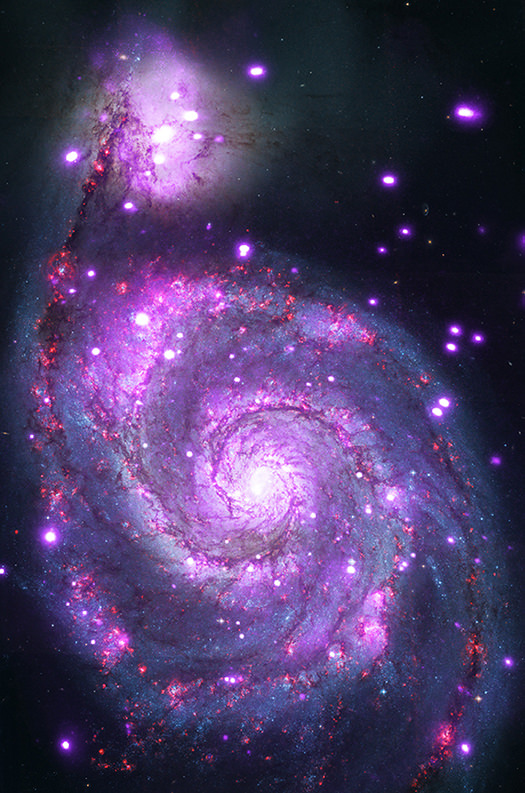In any galaxy there are hundreds of X-ray binaries: systems consisting of a black hole capturing and heating material from a relatively low-mass orbiting companion star. But high-mass X-ray binaries — systems consisting of a black hole and an extremely high-mass companion star — are hard to come by. In the Milky Way there’s only one: Cygnus X-1. But 30 million light-years away in the Whirlpool galaxy, M51, there are a full 10 high-mass X-ray binaries.
Nearly a million seconds of observing time with NASA’s Chandra X-ray Observatory has revealed these specks. “This is the deepest, high-resolution exposure of the full disk of any spiral galaxy that’s ever been taken in the X-ray,” said Roy Kilgard, from Wesleyan University, at a talk presented at the American Astronomical Society meeting today in Boston. “It’s a remarkably rich data set.”
Within the image there are 450 X-ray points of light, 10 of which are likely X-ray binaries.
The Whilpool galaxy is thought to have so many X-ray binaries because it’s in the process of colliding with a smaller companion galaxy. This interaction triggers waves of star formation, creating new stars at a rate seven times faster than the Milky Way and supernova deaths at a rate 10-100 times faster. The more-massive stars simply race through their evolution in a few million years and collapse to form neutron stars or black holes quickly.
“In this image, there’s a very strong correlation between the fuzzy purple stuff, which is hot gas in the X-ray, and the fuzzy red stuff, which is hydrogen gas in the optical,” said Kilgard. “Both of these are tracing the star formation very actively. You can see it really enhanced in the northern arm that approaches the companion galaxy.”
Eight of the 10 X-ray binaries are located close to star forming regions.
Chandra is providing astronomers with an in depth look at a class of objects that has only one example in the Milky Way.
“We’re catching them at a short window in their evolutionary cycle,” said Kilgard. “The massive star that formed the black hole has died, and the massive star that is accreting material onto the black hole has not yet died. The window at which these objects are X-ray bright is really short. It’s maybe only tens of thousands of years.”
Additional information available on the Chandra website.


Always a delight, views of both galaxies in my 4″ means I’ve got clear skies. But, this new view is like seeing M51 that first time!
“Chandra is providing astronomers with an in depth look at a class of objects that has only one example in the Milky Way.”
The implication that Cygnus X-1 is the only object of its type in the Milky Way seems wrong here. Cyg X-1 is known as as high mass x-ray binary(HMXB) containing a stellar mass black hole. At present there are over a dozen such HMXBs known or suspected to contain a black hole and residing in the Milky Way:
http://en.wikipedia.org/wiki/Stellar_black_hole#Candidates
Doesn’t seem fair to single out Cyg X-1 as the only example of an HMXB suspected to contain a black hole.
(And to be more inclusive, there are accreting HMXBs that contain neutron stars (pulsars) or white dwarfs. A partial list of HMXBs containing pulsars can be found here: http://en.wikipedia.org/wiki/List_of_X-ray_pulsars#HMXB )
Considering the assumption that Galaxies have been growing by swallowing smaller siblings …. it was to be expected.
When I grew up, black holes only existed in science fiction movies.
Look at now, we are surrounded by black holes.
When I grew up, planets only existed in science fiction movies.
Look at now, we are surrounded by planets.
In my current time, aliens only exists in science fiction movies.
What will happen in the near future. hmmm?
I’m pretty sure there’s more than one x-ray binary in our Milky Way galaxy. The catalog at http://heasarc.gsfc.nasa.gov/W3Browse/star-catalog/hmxbcat.html covers 114 high mass x-ray binaries, and the catalog at https://heasarc.gsfc.nasa.gov/W3Browse/all/ritterlmxb.html provides another 105 low mass x-ray binaries.
While it’s great to have new data, let’s not forget the old data that so many have worked so hard for so long to accumulate.
One thing for sure is, we’ll never understand how this awesome Universe works. Everything out there, is happening for a reason and is not happening randomly.